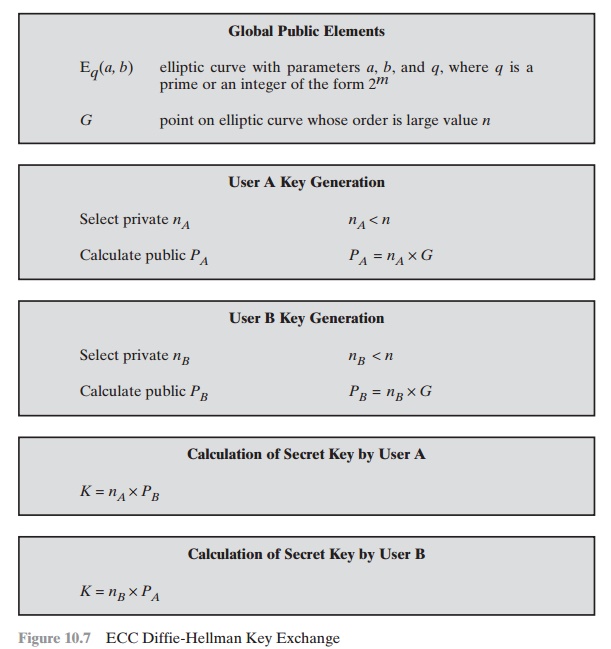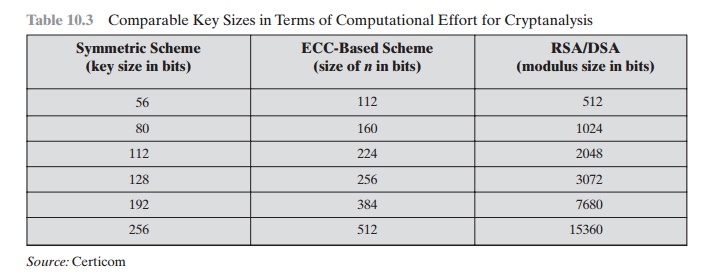Chapter: Cryptography and Network Security Principles and Practice : Asymmetric Ciphers : Other Public-Key Cryptosystems
Elliptic Curve Cryptography
ELLIPTIC
CURVE CRYPTOGRAPHY
The addition operation in
ECC is the counterpart of modular multiplication in RSA,
and multiple addition
is the counterpart of modular
exponentiation. To form a cryptographic system using elliptic
curves, we need to find a “hard problem” corre- sponding to factoring the product of two primes or taking the discrete
logarithm.
Consider the equation Q
= kP where Q, P Î EP(a, b) and k < p. It is rela- tively easy to calculate Q given
k
and P, but it is relatively hard to determine
k
given Q and P. This is called the discrete logarithm problem for elliptic
curves.
We give an example taken from the Certicom Web site(www.certicom.com).
Consider
the group E23(9,17). This
is the group
defined by the
equation y2 mod 23 = (x3 + 9x + 17)
mod 23 . What is the discrete logarithm k
of Q = (4, 5) to the base P
= (16, 5)? The brute-force method is to compute multiples of
P until Q is found. Thus,
P = (16, 5); 2P
= (20, 20); 3P = (14, 14);
4P = (19, 20); 5P = (13, 10);
6P = 17, 32; 7P
= 18, 72; 8P = (12, 17); 9P = (4, 5)
Because
9P = (4, 5) = Q, the
discrete logarithm Q = (4,
5) to the base P = (16, 5) is k =
9. In a real application, k would be so large as to make the brute- force
approach infeasible.
In the remainder
of this section, we show two approaches to ECC that give the flavor of this technique.
Analog of Diffie-Hellman Key Exchange
Key exchange using elliptic curves can be done in the following
manner. First pick a
large integer q, which is either a
prime number p or an integer of the
form 2m, and elliptic curve
parameters a and b for Equation
(10.5) or Equation (10.7). This defines the elliptic group of points Eq(a, b).
Next, pick a base point G = (x1, y1) in Ep(a, b) whose order is a very large value
n. The order n of
a point G on
an elliptic curve is the
smallest positive integer n such that
nG = 0
and G are parameters of the cryptosystem known to all participants.
A key exchange between users A and B can be
accomplished as follows (Figure 10.7).
1.
A selects
an integer nA less than n. This is A’s private
key. A then generates
a public key PA = nA * G; the public key is
a point in Eq(a, b).
2.
B similarly selects a private
key nB and computes a public
key PB.
3.
A generates the secret
key k = nA * PB. B generates
the secret key k = nB * PA.
The two calculations in step 3 produce the
same result because
nA * PB = nA * (nB * G) = nB * (nA * G) = nB * PA
To break this scheme,
an attacker would need to be able to compute
k
given G
and kG,
which is assumed to be hard.
As an example,6 take p = 211; Ep(0, - 4), which is equivalent to the curve
y2 = x3 - 4; and G = (2,
2). One can calculate that 240G = O. A’s private key is
nA = 121, so A’s
public key is PA = 121(2, 2) = (115, 48). B’s private key
is nB = 203,
so B’s public key is 203(2, 3) = (130, 203). The shared secret key is
121(130, 203) = 203(115,
48) = (161,
69).
Note that the secret key is a pair of numbers.
If this key is to be used as a session
key for conventional encryption, then a
single number must be gener- ated.
We could simply use the x coordinates
or some simple function of the x coordinate.

Elliptic Curve Encryption/Decryption
Several approaches to encryption/decryption
using elliptic curves have been ana- lyzed in the literature. In this subsection, we look at perhaps the simplest. The first
task in this system is to encode the plaintext message m to be sent as an x–y point Pm. It is the
point Pm that
will be encrypted as a
ciphertext and subsequently decrypted. Note that we cannot simply
encode the message
as the x or y coordinate
of a point, because not all such coordinates are in Eq(a, b);
for example, see Table
Again,
there are several approaches to this encoding,
which we will
not
address here, but suffice it to say that
there are relatively straightforward tech- niques that can be used.
As with the key exchange
system, an encryption/decryption system
requires a point G and an elliptic group Eq(a, b)
as parameters. Each user A selects a private key nA and generates a
public key PA = nA * G.
To encrypt and send a message Pm to B, A chooses a random positive
integer k
and produces the ciphertext Cm consisting of the
pair of points:
Cm = {kG, Pm + kPB}
Note that A has used B’s public key PB. To decrypt the ciphertext, B multiplies the first point in the pair by B’s secret
key and subtracts the result from the second point:
Pm + kPB - nB(kG) = Pm + k(nBG) - nB(kG) = Pm
A has masked the message Pm by
adding kPB to
it. Nobody but A knows the value of k,
so even though Pb is a public key, nobody can remove the mask kPB.
However, A also includes a “clue,” which is enough to remove the mask if one
knows the private key nB. For an attacker to recover the message, the attacker
would have to compute k given G and kG, which is assumed to be hard.
As an example of the encryption process (taken from [KOBL94]), take p
= 751;
Ep(-1,
188) , which is equivalent to the curve
y2 = x3 - x + 188; and G
= (0,
376). Suppose that A wishes to send a message to B that is encoded in the
elliptic point Pm = (562, 201) and that
A selects the random number k = 386.
B’s public
key is PB = (201, 5). We have
386(0, 376) = (676,
558), and (562, 201) + 386(201, 5)
= (385, 328). Thus, A
sends the cipher text {(676, 558), (385,
328)}.
Security of Elliptic Curve Cryptography
The security of ECC depends on how difficult it is to
determine k given kP and P. This is referred
to as the elliptic curve
logarithm problem. The fastest known
tech- nique for taking the elliptic curve logarithm is known as the
Pollard rho method. Table 10.3 compares various
algorithms by showing
comparable key sizes in terms of
computational effort for cryptanalysis. As can be seen, a considerably smaller
key size can be used for ECC compared
to RSA. Furthermore, for equal key lengths, the computational effort required for
ECC and RSA is comparable [JURI97]. Thus, there
is a computational advantage to using ECC with a shorter key length than a
comparably secure RSA.
Table
10.3 Comparable
Key Sizes in Terms of Computational Effort for
Cryptanalysis

Related Topics